Repair of a Neva gas water heater: typical violations in operation and repair technology
Have you met household appliances that have been working for many years without failures? We are sure not. Periodic attention is required for refrigerators, air conditioners, microwaves ...
Moreover, you should not be upset if the repair of the Neva gas water heater was required. After all, it can be completed quickly, and there will be no problems with spare parts. How exactly to identify and troubleshoot, says our article.
We will introduce the design features of the Neva brand equipment used in heating water for hygienic and sanitary consumption. The useful information presented by us will help you to accurately find the cause of the breakdown. Guided by our advice, you can restore the performance of the column without any problems.
The content of the article:
Design and principle of operation of the PGV Neva
In the series of flowing gas water heaters (PGW) of the Neva trademark, many models and modifications are presented. To date, the most popular are NEVA-4510M, NEVA-4511, NEVA 4513M with electric ignition.
They are manufactured at the factories of the domestic company BaltGaz Group in accordance with GOST 31856-2012 and include:
- metal case;
- gas path;
- water circuit;
- burner;
- combustion path;
- security system;
- management system;
- adjustment unit.
The listed nodes consist of many elements, some of which are shown in the diagram below.
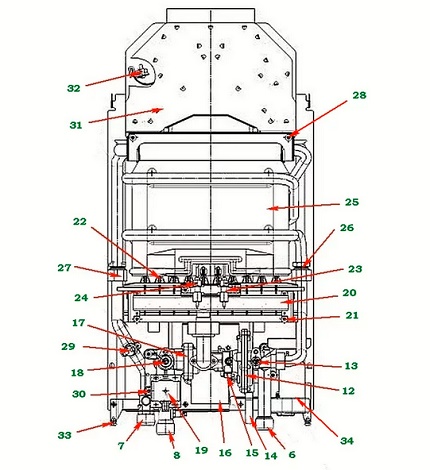
The water circuit begins with a pipe connected to a cold water pipeline and is pumped with a hot water pipe. This includes the water block, which plays a key role in electric ignition. It consists of a lower and an upper chamber, between which there is an elastic membrane.
When the tap is turned on, a stream of cold water rushes to the heat exchanger, but along the way passes the lower chamber and completely fills it. Under water pressure gas column membrane bends and presses on the poppet valve of the rod located in the upper chamber.
The rod of the water block extends through the hole and acts on the coaxially located rod of the gas block. That, in turn, acts on a mechanical gas valve, the plate of which moves away and gives gas passage, instantly filling the burner manifold.
At the same time, when the rod moves, the microswitch plate trips, closing the electric circuit.
Electric current is supplied from batteries located in the battery compartment and provides power to the control unit, which supplies electric voltage to the spark plug and opens the solenoid valve. Between the nozzle of the burner and the electrode of the spark sparks occur that ignite the burner.
The heat obtained by burning gas is transferred to the heat exchanger pipe through which water flows. As a result, a few minutes after turning on the tap, hot water pours from it. When the valve is turned off, reverse processes occur and the burner goes out.
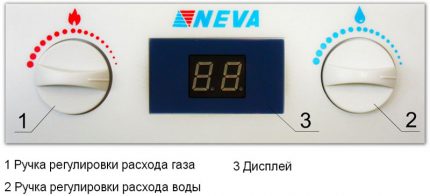
Gas is one of the cleanest types of fuel in the environmental sense, but carbon dioxide, water vapor, and nitrogen are also released during its combustion. Through the exhaust pipe and the chimney of the gas boiler, they are removed from the combustion chamber to the outside. The removal of combustion products is possible only if there is proper draft in the chimney.
To control the operation of the column and ensure its safe operation, the following sensors are included in the design:
- the presence of flame;
- the presence of traction;
- water temperature.
Thanks to these components, gas enters the burner only when the tap is turned on and there is water in the water supply. If the burner goes out for some reason, the gas supply immediately stops.
The automatic shutdown of the water heater is caused by the lack of proper draft in the chimney, the increase in water temperature at the water intake point to 90 ° С. If the pressure in the water circuit reaches a critical value of 1000 kPa, an emergency valve is activated and excess water is drained.
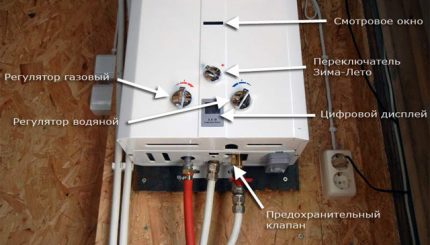
Now that you have familiarized yourself with the design and construction of the Neva gas water heater, you can proceed to the next chapter of the article, in which we list the most common malfunctions, the causes of their occurrence, and methods of elimination.
Please note that the manufacturer recommends to call the service center staff for maintenance and repair work related to disassembling the gas-water unit contract signed for the supply of gaseous fuels and equipment maintenance.
Most common malfunctions
The following problems indicate the malfunctions of various nodes when using a water heater:
- the burner does not light;
- the burner does not go out;
- the column switches off spontaneously;
- insufficient heating of water;
- overheating of water.
Let's see how it looks in practice. You open the faucet in the kitchen or in the bathroom, expecting that hot water will run out of it. But contrary to expectations, the burner does not light.Another situation: the column starts to work normally, but it soon turns off, although you did not block the water tap.
They wanted to wash their hands and nearly got burned, because boiling water was running from the tap. Or vice versa: they were going to take a shower, but the water was barely warm. A very unpleasant moment: you turned off the water, and the burner continues to burn.
These problems can have completely different reasons. Sometimes they lie on the surface, as is the case with dead batteries. But often you have to perform one complex operation after another to get to the bottom of the matter.
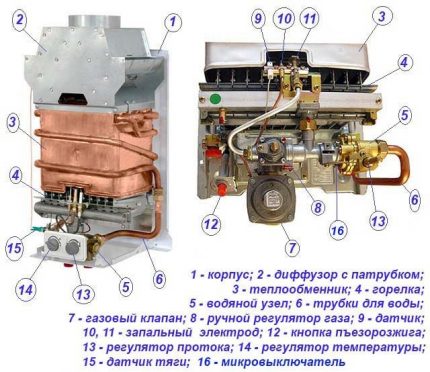
The work of home masters is hampered by a lack of experience, a professional tool and a thorough understanding principles of gas column. Therefore, proceeding to the diagnosis and repair, it is worth weighing all the pros and cons, guided by the principle of “do no harm”.
Problems due to lack of power
Gas is the fuel for Neva water heaters, however, they cannot work without electricity. The control unit, glow plug, solenoid valve and other components of the apparatus need a stable power supply. Its source is two LR20 alkaline batteries located in a separate, easily accessible compartment.
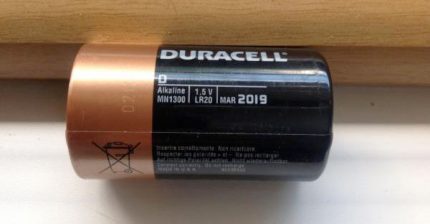
If there is no electricity, when you turn on the tap with water, a spark discharge will not occur or will be weak and the column will not turn on.
Lack of power can be caused by low batteries, oxidation of the contacts of the battery compartment, or an open circuit.
In case of incomplete discharge, the batteries can power the display, but their power will not be enough for more energy-intensive operations. Therefore, if you see that the display is working properly and displays temperature data, nevertheless strip the contacts of the battery compartment and replace the batteries with new ones similar or lithium CR20.
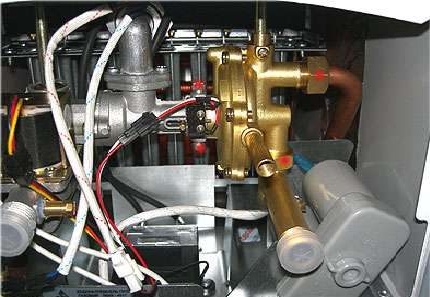
The battery cover is located at the bottom of the case and is accessible without disassembling the device. That is, you can clean the contacts and replace the batteries yourself. Elimination of the causes of underheating of water.
If the column still does not turn on with new batteries, you must check for scale in the heat exchanger tubes.
The formation of scale on the inner surfaces of the pipe prevents the normal passage of water, which can lead to the column being turned off. Also, a thick precipitate of magnesium and calcium salts significantly reduces thermal conductivity, the apparatus cannot provide the heat output stated in the accompanying documentation, which leads to insufficient heating of the water.

Recall in the instruction manual that clean the gas water heater and its heat exchanger is needed every 12 months. If the column is used intensively and hard water is used, scale will form more quickly, and therefore extraordinary cleaning may be required.
To do this, remove the casing and remove the heat exchanger. Before disassembling, the taps on the gas and water inlet pipes are closed. Remove the gas and water adjustment knobs by pulling them towards you. Some models have screws under the handles that are removed with a screwdriver. Also unscrew the screws, which fix the casing to the bracket from the bottom on both sides.
The wires connecting the water temperature sensor and the control unit to the display are disconnected. Remove the casing by pulling it toward you and sliding it up.Looking ahead, we note that after repair, the casing is installed in the reverse order.
So, the casing was removed and now it is necessary to remove the heat exchanger. Unscrew the plug located under the water unit and drain the remaining water from the heat exchanger. Disconnect the column connections from the hot and cold water pipes, remove the old gaskets. Remove the two screws and remove the metal plate securing the heat exchanger from above.
Remove the heat exchanger and place in a container with a hot solution of detergent for dishes or ordinary laundry soap. After 15 minutes, remove the soot from the grill and other surfaces with a soft brush. Rinse the grill and other surfaces under a strong stream of water.
To remove scale from the pipes, a warm solution of citric acid is prepared at the rate of 100 grams per 1 liter of water heated to 40 ° C. The resulting solution is poured into the heat exchanger tube and drained after 15 minutes. The pipe is washed with water. If necessary, repeat the procedure.
When installing the heat exchanger in place, detachable joints are sealed with new gaskets. Do not tighten the connections too much so as not to transfer the gasket. Otherwise, its transferred edge may be in the pipe in the path of the water flow, which will cause unpleasant noises. Installing gaskets with a bias will lead to similar consequences.
Damage to the gas-water unit
If the power supply is provided, the heat exchanger is clean, but the water heater does not turn on, you will have to disassemble the gas-water unit to determine the condition of the membrane and the stem.
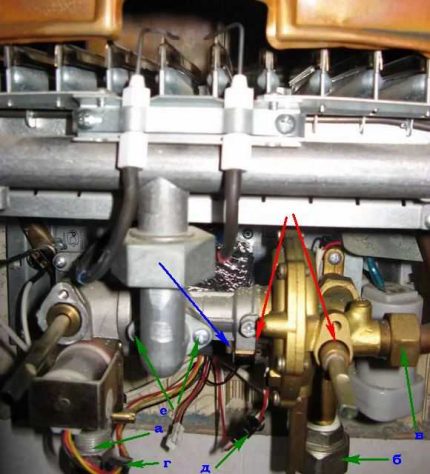
We repeat that for repair work gas and water taps must be shut off. The water unit is dismantled together with the gas one.
The gas and water connections are disconnected, the nut of the heat exchanger nozzle is unscrewed, the wires connecting the electromagnetic valve to the control unit and the wires of the microswitch are opened.
The screws connecting the gas-water assembly and the nozzle of the burner manifold are unscrewed. Now this assembly can be removed and placed on the table for further disassembly.
Having unscrewed several screws, the gas block is separated from the water block and set aside. Further work only with the water block. Unscrew the screws located around the perimeter. The block is divided into two parts, between which the membrane is located.
The membrane is removed and inspected. Most often, it is because of her sprains or breakthroughs that the column cannot be turned on. During the reassembly, the new membrane is placed in the standard socket. The rod is installed in such a way as to ensure its translational movement, without jamming.
When Solenoid Valve Replacement Required
If the solenoid valve fails, gas does not enter the system and the column does not turn on. The valve is removed from the apparatus, but not disconnected from the control unit.
By simulating the supply of water to the system by moving the pusher of the microswitch, the ability of the valve to retract and hold the rod is determined, opening the gas passage to the burner. If the valve does not work, replace it. To do this, disconnect the wires, remove the gas-water unit, unscrew the fastening screws, remove the old valve and install a new one in its place.
Incorrect burner operation
The displacement of the spark plug electrode or the formation of soot on it leads to the absence or weakening of the ignition spark and, as a result, to the failure of the column to turn on. Also, due to problems with the spark plug electrode, an increase in gas concentration in the combustion chamber is possible. For this reason, ignition is accompanied by a loud bang.
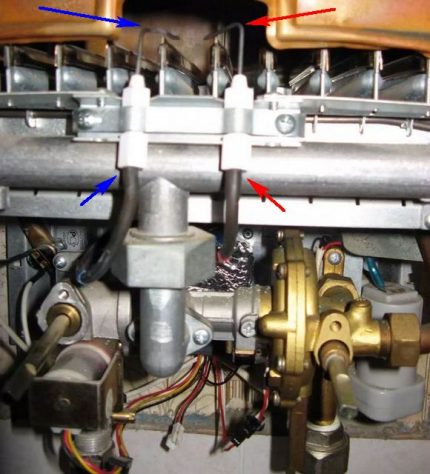
It is enough to clean the electrode with sandpaper and return it to its regular place so that the spark “works” and extraneous noise disappears.
If the burner becomes clogged, its flame weakens and begins to smoke. As a result, water does not heat up to the intended temperature. Before cleaning, the burner is removed, for which the wires of the ionization sensor and the spark plug are disconnected, the nut of the collector pipe and two screws are unscrewed, the collector is removed, two more screws are unscrewed and the burner block is disconnected.
Brush clean the surfaces of parts. Brush a suitable size to clean the internal channels. After dust removal, the parts are washed with dishwashing detergent, rinsed and, after drying, put back in place. The flame of a clean, working burner is blue.
Sensors and circuitry or why does the burner go out
As mentioned in the chapter on the device of the water heater, the security system includes three sensors that are connected in series in a single electrical circuit.
It is enough to fail one of them in order for the circuit to open and the speaker to turn off.
The ionization sensor installed on the burner, as well as the spark plug, is equipped with an electrode that can become dirty or change its position, and then not “see” the flame. With such a malfunction, the water heater starts working normally, but after a few minutes the burner goes out, as the solenoid valve shuts off the gas.
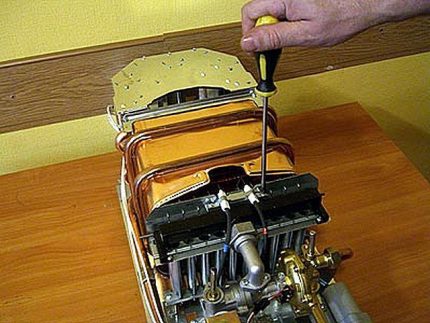
The flame sensor electrode is also cleaned with emery paper, after which it is set so as to “see” the flame.
The gas column with the Neva logo goes out and due to an improperly equipped chimney or its clogging. With poor traction, the removal of combustion products becomes impossible. To prevent the accumulation of harmful substances in the room, the corresponding sensor is activated and the column turns off.
When the water temperature reaches 90 degrees, the overheating sensor responds and the column urgently stops its work. The reason usually lies in the incorrect adjustment of the gas and water supply, or in the insufficient pressure of the water supply network.
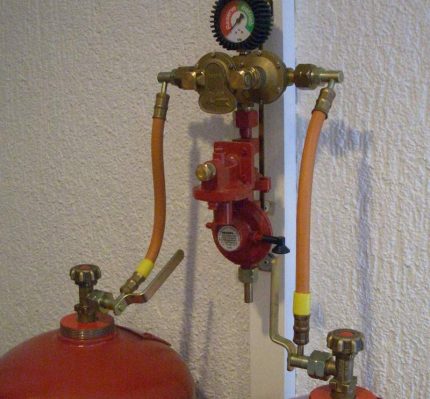
Sometimes it’s enough to turn the gas control knob to the minimum or increase the flow of water to stop the column shutdown. You also need to set the winter / summer knob in the appropriate position on time.
Operability gas water heater sensors and the integrity of the electrical circuit is checked with a multimeter. If the sensors are operational, the electrical resistance is close to zero. An error code also signals a breakdown of the overheating sensor - instead of the usual water temperature indicators, the letters “EE” are displayed.
If there is no device for measuring resistance, the test is carried out by setting jumpers to close the circuit and turn on the column. If the speaker works normally with such a connection, it means that the sensor under test is faulty and needs to be replaced.
It must be remembered that installing jumpers is only a diagnostic method, not a repair method. It is forbidden to use a column with jumpers instead of sensors.
Conclusions and useful video on the topic
The video demonstrates the process of replacing the batteries of the Neva water heater:
The video is devoted to typical malfunctions of gas instantaneous water heaters:
Geysers of the Neva are unpretentious in maintenance and repairable.Disassembly and assembly require a minimum set of tools.
The technical documentation enclosed with the product provides clear instructions on troubleshooting and repair. Possible replacement of individual parts and assemblies. Spare parts are available in the BaltGas Group manufacturer's chain of stores and at its dealers.
Want to share your own experience in restoring the functionality of a Neva gas column? Do you have useful information on a topic that may be useful to site visitors? Please write comments in the block below, post a photo, ask questions.

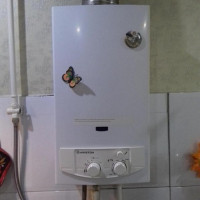 The principle of operation of a gas column: features of the device and operation of a gas water heater
The principle of operation of a gas column: features of the device and operation of a gas water heater 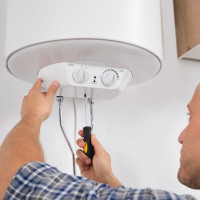 How to make a repair of a water heater with your own hands: methods available for a home master
How to make a repair of a water heater with your own hands: methods available for a home master 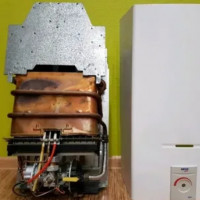 Do-it-yourself vector gas column repair “Vector Lux”: common breakdowns + tips for fixing them
Do-it-yourself vector gas column repair “Vector Lux”: common breakdowns + tips for fixing them 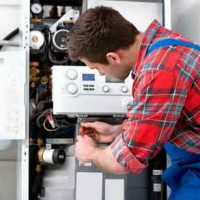 How to replace the gas column membrane: reasons + repair instructions
How to replace the gas column membrane: reasons + repair instructions 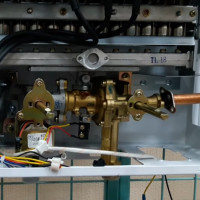 Repair of a water column of a geyser: assembly of a node, major breakdowns and detailed instructions for repair
Repair of a water column of a geyser: assembly of a node, major breakdowns and detailed instructions for repair 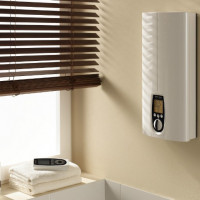 DIY instantaneous water heater installation: step-by-step instruction
DIY instantaneous water heater installation: step-by-step instruction  How much does it cost to connect gas to a private house: the price of organizing gas supply
How much does it cost to connect gas to a private house: the price of organizing gas supply  The best washing machines with dryer: model rating and customer tips
The best washing machines with dryer: model rating and customer tips  What is the color temperature of light and the nuances of choosing the temperature of the lamps to suit your needs
What is the color temperature of light and the nuances of choosing the temperature of the lamps to suit your needs  Replacement of a geyser in an apartment: replacement paperwork + basic norms and requirements
Replacement of a geyser in an apartment: replacement paperwork + basic norms and requirements